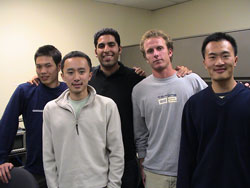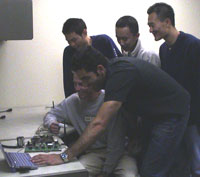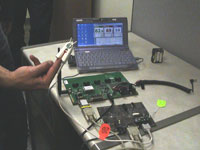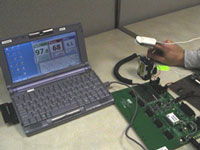Undergrad Electrical Engineers Develop Wireless Pulse Oximeter Prototype for Emergency Response
|
4.12.04 -- Imagine there's been a large-scale disaster at QUALCOMM stadium in San Diego. Five hundred people are dead. Quadruple that number need medical attention - right now. The injured are in such serious medical need and in such numbers that they can't all be transported right away to emergency rooms. How do the authorities cope?
Leslie Lenert, PI on the WIISARD project and associate professor at the VA Medical Hospital at UCSD, has a National Library of Medicine-funded plan to support the research to develop prototype telecom/IT systems that could save large numbers of lives in exactly this type of scenario. To support his vision, Lenert has teamed with an increasingly well known class offered at UCSD. His goal? To harness the talent and enthusiasm of undergraduates.
|
Yes, that's right: undergraduates.
Says Lenert, "It's been said that undergraduates are among the most creative problem solvers because they have good foundations in their technical disciplines, but they still believe anything is possible. We love - and want to encourage - that!"
The class is identified in UCSD's course offerings rather nondescriptively as ECE 191. But students know it well. This is the class they all want to take. This is the class, many say, that changes them: It helps them define career goals and determine whether they want to pursue graduate school. They say it's where they learn how real engineering is done. And that can be a litmus test on whether those in doubt decide to become professional engineers.
ECE refers to the department of Electrical and Computer Engineering, and the number indicates it's intended for seniors majoring in the discipline. Led by professors Paul Yu and Clark Guest, it's designed to help students move one important step beyond the theory, math, and physics that UCSD is rightfully known for into the "hands-on, we build it" domain. That's not something that universities normally offer.
Many of the projects are suggested by Calit² and its industrial partners. And students love it: They love the concept, they love the teamwork, and they love their mentors that supervise their group projects.
Some of them apparently can't get enough. One team, described in this article, gained so much from their experience during winter quarter that, just recently, they've volunteered to continue developing their prototype further - without credit and without pay. Their advisor marvels at this - but he's not surprised.
"I'm really impressed by the zeal and enthusiasm this team has shown in accomplishing the task," says advisor Doug Palmer. "Besides inventiveness, persistence, and dogged determination to get the demonstration system finished, they did it all with a marvelous sense of humor."
Palmer is a researcher at Calit², with long-standing experience with startup companies in San Diego. He's not a tenure-track faculty member, so, in an academic setting, he is something of an anomaly for students to work with. But that's exactly the value-added that Calit² research staff members bring to the campus and the students: Not -- business -- as -- usual. Students figure this out right away -- and they understand the value.
"Doug is a genius," volunteers team member Ivan Wong. "He, of course, can do the project in something like a week. But he gave us the opportunity to learn through trial and error."
Rick Pan also appreciates Palmer's influence: "Doug knows the real world, and we don't. His guidance saved us a lot of trouble. One thing he told us at the beginning of the quarter was specsmanship, that is, how to select and obtain the parts from a company. When we encounter problems in part ordering, Doug was the one that helped us get the parts we needed. We're proud to say that, because of Doug's guidance, we only spent half of the budget Calit² provided."
Says Palmer, "What talented students to work with! This class is doing on a small scale what Calit² is doing on a large scale for the entire university, maybe even the entire UC system. I'm delighted to be a part of it - in both the smaller and larger contexts."
The project this team worked on was for WIISARD, the Wireless Internet Information System for Medical Response in Disasters. WIISARD seeks to apply sophisticated wireless technology to coordinate and improve the medical care of large numbers of critically injured victims at the scene of a terrorist attack or natural disaster. It's also one of Calit²'s flagship projects.
The goal was to develop a low-cost device that easily could communicate patients' vital signs to doctors wirelessly over the Internet. Pulse-ox devices, as they're known in the medical world, are a very simple, but authoritative, way to determine quickly a patient's overall health status:
Are they going to die shortly?
Lacking immediate medical assistance, will they die in the near term?
Can they wait for assistance because many others with more serious health needs need to be addressed first?
These are the fundamental questions that emergency medical responders in this kind of triage situation grapple with to prioritize patient care to save the largest number of lives overall.
The objective of the project was to create a system that could monitor hundreds of patients simultaneously and yet be inexpensive enough that budget-strapped first responders could afford it. To achieve this, the team created the first pulse oximeter device designed for a ubiquitous wireless Internet environment.
The students worked with two hardware vendors: Dolphin Medical supplied the pulse oximeter finger clip and signal processor, and DPAC supplied the 802.11 transport scheme. Palmer sketched out a roadmap, and the team met every two weeks, setting follow-on goals and assessing progress as a team, working weekends as the team deemed necessary.
All opted for this project as their No. 1 choice based on a written description provided by Palmer the first day of class. None had had any personal interaction with Palmer prior to this class.
The students, individually, made for an interesting team. They also represent the Calit² philosophy of bringing together a variety of people with different skills and motivations: Significantly, they also have the personal skills to make the teamwork work.
Benjamin Pouladian focused on project management. He had experience in industry bringing a product to market, and he was most interested in maximizing team productivity and parts procurement - "keeping the process moving," in his words. He also has excellent communication skills and, as a result, was able to obtain contributions for free from vendors.
Jon Dunbar, with a technical engineering focus, studied the characteristics of the DPAC WiFi chip: how it would fit into the project, and how would it interface it with other parts? He assumed the role of the DPAC "specsmanship" master.
Rick Pan oversaw research on batteries, power consumption, and related part ordering. He interfaced with engineers from industrial partner Dolphin, trouble shooting problems. In fact, Dolphin was so interested in this project that one of their engineers participated in a March 8 teleconconference to assist. "We took that as a big vote of confidence," says Pan with a big smile.
Kuochao Tseng focused on communicating the projects' challenges and results: He developed all documentation and presentations. He was the one that could explain best the big-picture "vision" of the project. He developed Gantt charts describing project progress and Powerpoint slides for the class final presentation. His skills, not always evident in engineering undergraduates, underscored the importance of communication skills in any highly regarded engineering degree curriculum.
Ivan Wong studied hardware interfacing, that is, how should the wireless and Dolphin modules communicate? - "glueing" in his word: How do you connect the parts together so that they work? "We bought parts from different manufacturers," says Wong. "We glued parts from TTL logic to RS-232, but the various kinds of hardware speak different languages. So I looked at signal conversion: How does the serial signal from the finger sensor that's taking the vital signs convert to a signal that the DPAC wireless module can use so as to communicate outward through the Internet to those that need to be able to read that signal? We used an oscilloscope to make sure the signal was converted properly."
Pan describes the benefits of the group interaction: "Working in a team to do research is challenging, but it's effective. We all have our unique strengths. Everyone contributes his knowledge and, at the same time, we learn things from each other. No matter how good an engineer I am, I know I have weaknesses. Working with different people is the best way to improve my productivity and the overall productivity of the group."
"It completed my EE undergraduate experience at UCSD," says Wong. "It helped me understand what the theory I learned in class meant in practice. It helped me see how textbook equations and theory could be applied to a real-life engineering project."
Two groups in the follow-on ECE 191 class this quarter are planning to carry this work forward - one on signal processing and one that will focus on enhancing the technical capabilities of the device.
But they'll be challenged by the experience and enthusiasm of the students that have made this project their own and are continuing to work on it as well.






